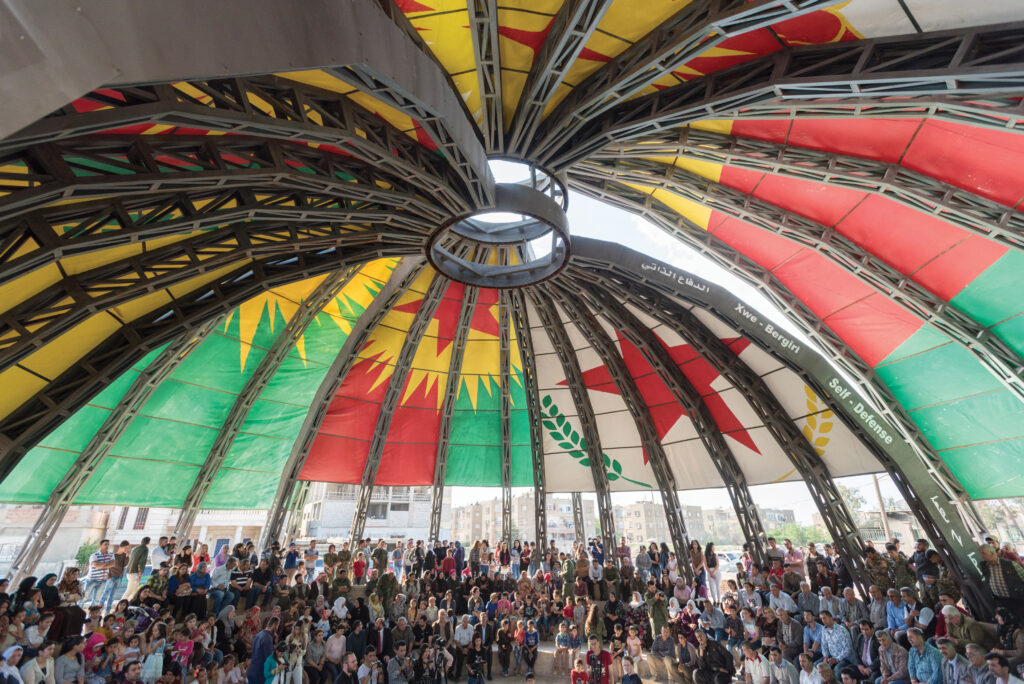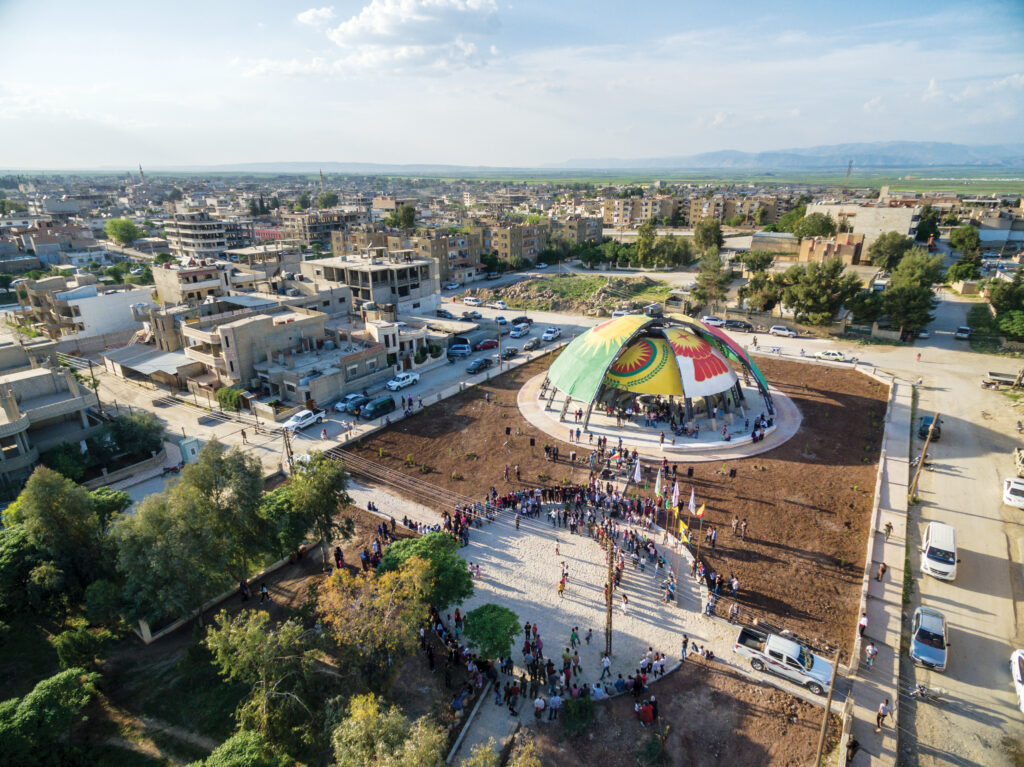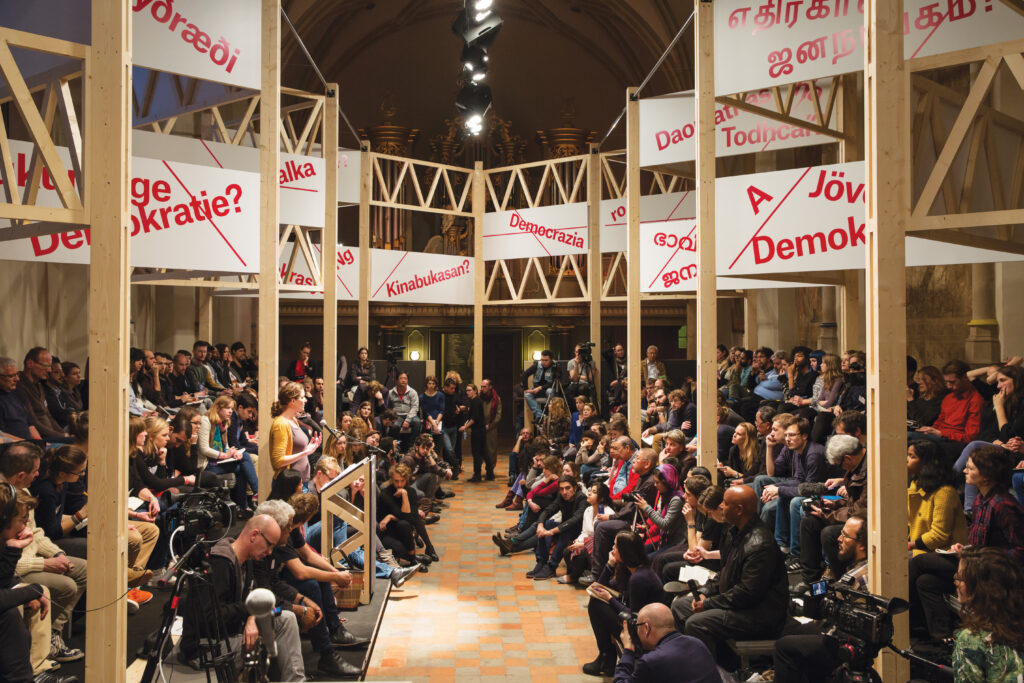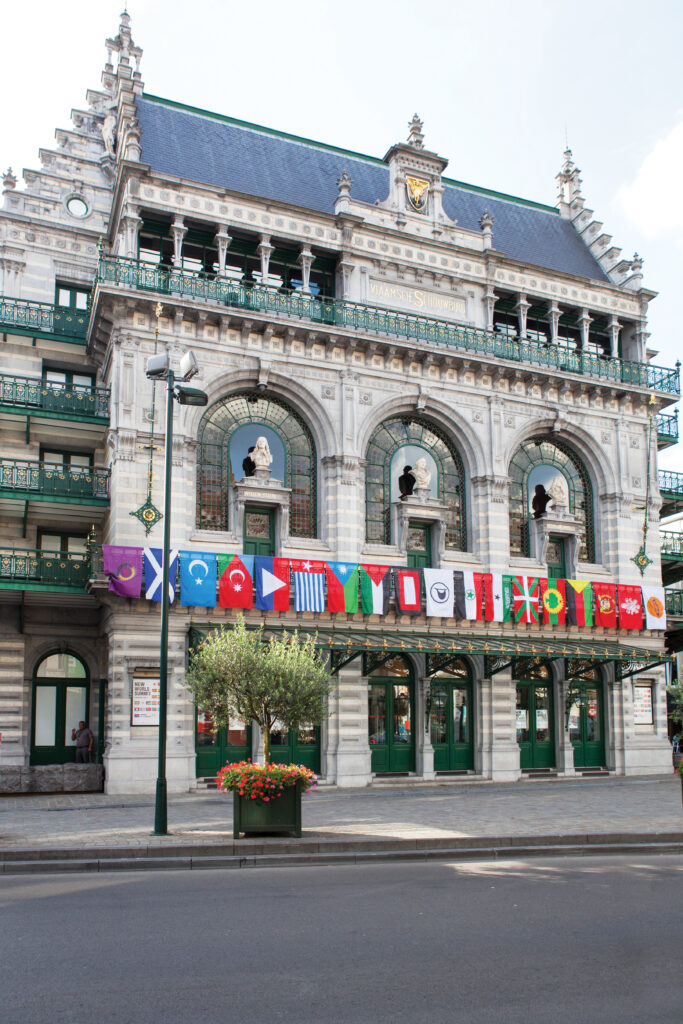
The inauguration of the People’s Parliament of Rojava in Dêrik. Photo by Ruben Hamelink, courtesy of Jonas Staal.
Editor’s Note
__
When I met Jonas Staal in 2013, his first iteration of the New World Summit had recently taken place. The summit brought together people from around the globe who were labelled terrorists by one state or another due to political beliefs, social and political affiliations, nomadic cultural conditions, or other unknown qualifying acts. Staal’s idea was straightforward. The refusal of state acknowledgement created a special class of people whose embodied knowledge and methodologies could perhaps be productively shared if art could break down the barriers to their assembly in public institutions in countries that have blacklisted them. Importantly, such a gathering could yield the “imaginative force redefining the space and practice of the commons” so desperately missing from the state politics of the moment.
What follows is a “Field Report” that offers a view inside Staal’s early thinking which has evolved into, among other initiatives, two particularly profound experiments. The first was a collaboration with the coalition of Kurdish, Arab, and Assyrian peoples that brought about the Rojava Revolution, which has inspiringly created an autonomous region in Northern Syria, centering women’s rights, equity, and religious freedom. The second was a more traditional book project that contains a set of unconventional ideas titled Propaganda Art in the 21st Century (MIT 2019). Among the attendees of the first summit were representatives from the Kurdish Women’s Movement. Their relationship with Staal subsequently deepened and led to an invitation in 2015 to design and build a public parliament building in Rojava that explicitly reflects the values of the Rojava Revolution. It was completed in 2018. Staal’s book, parallel to many of the ideas embedded in the Rojava project, proposes the potential for propaganda art that is premised on mutual emancipation, rather than the consolidation of power into the hands of a few. The book grows from years of this work, including a desire to use art-driven assemblies to create “an independent network of references, histories, and symbols that define identity, even beyond what a territorially or legislatively defined state might ever be able to obtain” as a means of creating new transnational realities. The work of imagining possible alternative governance structures that would enable such transformation, as art and as politics, for Staal, is intrinsic to the thinking outlined below.
—Laura Raicovich
Reprinted with permission, this article originally appeared in ART PAPERS, May/June 2014, vol 38.03.
I. Christina Aguilera, Dinosaurs, and Capitalist Democracy’s Mass Torture
On March 3, 2006, a leaked file documenting an interrogation at Guantánamo prison in Cuba was released via Time magazine’s website. The log contained a detailed report on one and a half months of the torture of Saudi citizen Mohammed Mani Ahmed al-Kahtani, the suspected 20th hijacker from the attacks on the Twin Towers and the Pentagon in September 2001.1 Personally approved by Donald Rumsfeld, the United States’ then Secretary of Defense, the methods used were known as “enhanced interrogation techniques,” and they included “extended sleep deprivation, forced standing (also known as stress positions), isolation, manipulation of heat and cold, noise bombardment, personal humiliation, and mock execution.”2 The myth of the efficiency and acceptability of what had at the time been dubbed “torture lite” (sic) has since been discredited; less attention, however, has been given to the bizarre but systematic use of Western pop cultural output as means of torture.3
Guards at Guantánamo moved al-Kahtani between closed, darkened spaces; they deregulated his sleep patterns, disorienting him and making it impossible for him to know when to pray and in which direction. Then they blasted him with Christina Aguilera’s 2002 hit “Dirrty.” Al-Kahtani was exposed to pinup girls and pornography, non-halal McDonald’s food, and strobe lights. All these are ostensible products of a “liberated” Western culture, subverted in Guantánamo as tools of oppression.
On January 10, 2003, at 22:45, al-Kahtani’s interrogator allowed him the rare opportunity to choose a topic to talk about. According to the log, the “[d]etainee wanted to talk about dinosaurs.” Al-Kahtani’s response reaches back from a brutal present into a prehistory untarnished by such evidence of civilization as fast food, Playboy, and Christina Aguilera. This choice of topic was not naïve but radical, reaching far beyond the oppressive iconographic realm of his confines at Guantánamo.
This choice of topic was not naïve but radical, reaching far beyond the oppressive iconographic realm of his confines at Guantánamo.
Yet the guards’ log bypasses Al-Kahtani’s escape from the terror of the present, noting only the following: “Interrogator gave history of dinosaurs and talked about the meteor that wiped them out, and equated this event with nuclear war. Detainee expresses great ignorance about dinosaurs and space, topics that are taught in U.S. grade schools.”4 The Guantánamo logic thus reduces veritable meaning—given here in the simile, “nuclear war poses a threat to humans like that which a meteor may have posed to the dinosaurs”—to a matter of “true or false?”
The leaked interrogation logs furthermore engage a disturbing understanding of the very culture from which their agents emerge: if the everyday décor of consumer society is a bona fide instrument of torture, according to Guantánamo logic, then surely it must be “true” that we are currently undergoing permanent, mass cultural torture as subjects of what Alain Badiou has referred to as “capitalist democracy.”
Although “democracy” is a single word, we may observe its use across the political spec-trum, employed in the name of such radically different operations as the “war on terror” under which al-Kahtani was tortured, and the massive social movements to have crossed the globe in the 21st century since Spain’s 15 million indignados began to occupy southern Europe. What is needed, then, is a vocabulary that allows us to differentiate between the language of emancipation and that of repression.
II. Lenin in Japan
Vladimir Lenin goes to Japan. To speak to the masses there, he must use a translator. When he comes to his fundamental critique of what he considers to be a “bourgeois democracy,” the translator becomes confused. At this moment, it is clear to Lenin that in Japanese the word “democracy” (minshushugi) has yet to be formulated. It is best translated as an “-ism” (-shugi): democratism.
Subversion results from this translation; “democracy”—the term—is broken, then doubled up to produce another. Through what we might now label as a Deleuzian proposal, Lenin has spoken about what he knows best, in the language he knows the least—one in which the democratic had yet to be formulated in language, just as, elsewhere, it had yet to be put into actual practice.
Lenin adopts the term. In “Working-Class and Bourgeois Democracy” (1905), he writes of a “Russian bourgeois democratism,” reflective only of the interests “of the mass of tradesmen and manufacturers, chiefly medium and small, as well as (and this is particularly important) those of the mass of proprietors and petty proprietors among the peasantry.”5 Today, it is this concept of democratism that philosopher Alain Badiou refers to as the “capitalo-parliamentarian order.”6 And the “liberated” symbols of pop culture produced by the creative industry should be considered its art, and its preferred weapons of intellectual mass torture.
Upton Sinclair’s Mammonart (1924) seeks to analyze the history of art as a history of the ruling classes, beginning with a group of cave-men who discover that when they dedicate art to the honor of their leader, they are rewarded with privileges and protection. The history of art as something more than the narration of the dominant class has, according to Sinclair, yet to be written. On the extended prehistory of art, he wrote: “The artists of our time are like men hypnotized, repeating over and over a dreary formula of futility. And I say: Break this evil spell, young comrade; go out and meet the new dawning life, take your part in the battle, and put it into new art; do this service for a new public, which you yourself will make … that your creative gift shall not be content to make artworks, but shall at the same time make a world; shall make new souls, moved by a new ideal of fellowship, a new impulse of love, and faith—and not merely hope, but determination.”7
Sinclair may well have subscribed to Andrea Fraser’s dictum: “We are all already serving.” Our task, as political artists, is to liberate our media from that servitude, to work toward genuine emancipation from the symbols that now legitimize torture and mass cultural oppression. We are in need of an art after democratism.
Our task, as political artists, is to liberate our media from that servitude, to work toward genuine emancipation from the symbols that now legitimize torture and mass cultural oppression.

The inauguration of the People’s Parliament of Rojava in Dêrik. Photo by Ruben Hamelink, courtesy of Jonas Staal.
III. Toward an Art of the Stateless State
a. The New World Summit
The first act necessary to free art from its complicity in the mass cultural torture of democratism is to rearticulate the political context in which we want art to be operational. Making art in defense of fundamental democracy—as opposed to democratism—means demand-ing of art that it not only reflect a progressive, emancipatory politics, but also that it contribute to the shaping of its ideals. That is, the art that is required is not simply a product of politics, but a political force in itself.
In recent years I have worked with political parties, nonparliamentary political organizations, and social movements focused on exploring what role art might play once it is resituated within an alternative political sphere, and how this political sphere might change once artists engage it. In my own practice, these endeavors have led to an artistic and political organization called the New World Summit. Since 2012, the New World Summit has developed a series of “alternative parliaments” worldwide, providing a forum for political and juridical representatives from organizations that have been excluded from democracy, listed as terrorists, banned from travel, and financially immobilized, with their assets frozen. The alternative parliaments of the New World Summit seek to situate art outside of what Sinclair described as its “extended prehistory” of political exclusion and oppression.

Researcher Jolle Demmers chairs a session with Callum Clayton-Dixon (Aboriginal Provisional Government, APG), Emory Douglas (Black Panther Party, United States), Ilena Saturay (National Democratic Movement of the Philippines), Richard Bell (artist, Aboriginal Tent Embassy), and Vivian Ziherl (Frontier Imaginaries) during the 2016 New World Summit – Utrecht. Photo by Nieuwe Beelden Makers, courtesy of Jonas Staal.
These international gatherings have included organizations that are internationally considered to be state threats. In the European Union, a committee called the Clearing House was formed following the September 11, 2001 attacks to draw up the blacklist. The Clearing House meets biannually in Brussels, but there are no public proceedings or records of the body’s selection process. Even by its own standards, the committee in charge of deeming which organizations are to be placed “outside” the ideals of democratism is organized in a fundamentally undemocratic manner.8 Consequences for listed organizations and related individuals include blocked assets and an international travel ban.
The New World Summit attempts to explore at what level art can serve as a tool to bypass these restrictions. We have tried to circumvent them by operating as a nomadic parliament: the New World Summit has no fixed geographical location, as it represents no nation state. We make maximum use of the exceptional juridical status of art—that is, of the fact that art, today, is rarely simply present, but rather always simultaneously questioning the conditions of this presence. This radical ambiguity, we believe, creates the transformative space in which progressive politics can take shape, free from the restrictive legislative fallout of global anti-terrorism initiatives. Where politics fails, and where democracy’s deep state reveals itself at its most explicit, art operates to sustain an alternative political sphere.

Flags of unrecognized people and states hang on the front of the KVS Royal Flemish theater in Brussels where the New World Summit – Brussels took place in 2014. Photo by Ernie Buts, courtesy of Jonas Staal.
The first of the three editions of the New World Summit to have taken place so far occurred May 4–5, 2012, in the Sophiensaele, a theater and space for cultural and political discourse located in Berlin. Invitations were dispatched to roughly 100 organizations mentioned on one of the many international lists of designated terrorist organizations. During this inaugural summit, we were able to host four political and three juridical representatives—as in lawyers—from the following organizations: the National Democratic Front of the Philippines, a guerilla faction that, since the 1970s, has opposed what they consider to be the country’s US puppet regime; the National Liberation Movement of Azawad, a Tuareg-led group of insurgents that took over two-thirds of Mali in 2012, striving, in their words, for a “multi-ethnic” and “multi-religious” secular state; the Basque Independence movement, which seeks to redefine the notion of Basque citizenship such that it might be applied to global struggles for self-determination; and the Kurdish Women’s Movement, which works in opposition both to the Turkish State and to the male dominant structure within the Kurdish revolutionary movement. Fadile Yildirim, who represented the KWM, proposed a radical feminist reading of history in order to “liberate democracy from the state.” In her words Lenin’s “democratism” is echoed: for Yildirim, it is the legalized structure within which the secondary status of women is inherently inscribed.
“Democracy” may well have been made possible by state structures, but in order to shape its core principles of egalitarianism—the equal distribution of power and knowledge—we must liberate it from the state, thus disentangling its power monopolies and oligarchies from the capitalist doctrine. I propose a necessary art of the stateless state—an art not subject to prehistoric cultural and political structures, but an art that is a driving, imaginative force redefining the space and practice of the commons.
I propose a necessary art of the stateless state—an art not subject to prehistoric cultural and political structures, but an art that is a driving, imaginative force redefining the space and practice of the commons.
b. The New World Academy
In the context of the New World Summit, art acts as an imaginative space for a different political arena: the “alternative parliament.” We founded the New World Academy in collaboration with BAK, Base for Contemporary Art in Utrecht, the Netherlands, in order to continue our exploration of art as a force for political restructuring. The New World Academy is a school that invites stateless political groups dealing with systematic political exclusion to work with artists, scholars, and students over a period of three days, during which participants investigate the various roles art might play at the center of political struggle, developing related projects in collaboration with one another. Here, we seek to trace the historical narratives and practices of stateless art.
For instance, the New World Academy invited the refugee collective We Are Here—a group of 225 undocumented migrants who organized themselves politically in 2012—to teach at the school. We Are Here worked with our participants to explore new models for cooperation between artists, students, and refugees. Members of Pirate Parties International were also invited to teach; they developed a “Pirate School” called the Alternative Learning Tank (ALT), in which teachers, students, and citizens were taught basic techniques of email encryption and anonymous Internet use. Both organizations operate from a condition of statelessness, be it by choice, with the Pirate Parties, or by force, in the case of We Are Here; this condition, we learned, nurtured models for political organization and cultural practice capable of opposing the democratist doctrine, by necessity or by choice.
Teachers from the National Democratic Movement of the Philippines provided a practical application of our theory of art in the stateless state. This organization consists of a variety of underground movements and semi-legally recognized political parties and factions, all of which share a strong leftist, Maoist signature. Together with Movement representatives, our participants developed a new model for “people’s trials”—a trial format intended to allow a civilian base to prosecute larger powers. The historical origins of the National Democratic Movement of the Philippines can be found in the revolutionary figure of Andrés Bonifacio (1863–1897), who in 1896 declared Filipino independence from Spain, which had occupied the country since the 16th century. Bonifacio was aided by the United States, which promised the establishment of an independent Filipino republic during the Spanish-American War of 1898. However, the United States occupied the country until 1946, after which, according to the National Democratic Movement, it continued to instrumentalize subsequent “independent” governments of the Philippines.
In the 1960s, Professor Jose Maria Sison, founder of both the Communist Party of the Philippines and the New People’s Army, called for a Second Propaganda Movement, a cultural uprising that demanded independence.9 It is in this context that the figure of the artist as “cultural worker” emerged and became central to understanding the role of art within the National Democratic Movement. The cultural worker, within this movement, broadcasts the Filipino people’s right to self-determination, inscribing it through words and images in the imagination of an unrecognized state. The cultural worker uses artistic tools in order to uphold and to communicate the narratives and convictions of the marginalized and the dispossessed. He or she is educator, agitator, organizer, engaged in the maintenance of the symbolic universe of the unacknowledged state—not so much an administrative entity, but rather a collectivity, participant in a shared visual language. As such, a kind of meta-state is created in details; it possesses an independent network of references, histories, and symbols that define identity, even beyond what a territorially or legislatively defined state might ever be able to obtain.10
It is within this stateless state that we find the condition that may be understood as a “permanent revolution”—that is, a permanent process of collectively communicating, critiquing, and shaping our understanding of culture, not as an administered identity but as one in constant movement. This does not mean that art can replace—or must obliterate—state structure; instead it suggests that if there should ever be such a thing as a state, it should be reflective of the permanent process through which a people’s culture manifests and expresses itself, not as an administered entity, restricted or restricting any form of communication. Art of the stateless is our way out of prehistory.
Jonas Staal is a visual artist whose work deals with the relation between art, propaganda, and democracy. He is the founder of the artistic and political organization New World Summit (2012–ongoing) and the campaign New Unions (2016–ongoing). Recent exhibition-projects include Art of the Stateless State (Moderna Galerija, Ljubljana, 2015), After Europe (State of Concept, Athens, 2016), The Scottish-European Parliament (CCA, Glasgow, 2018) and Museum as Parliament (with the Democratic Federation of North Syria, Van Abbemuseum, Eindhoven, 2018-ongoing). His projects have been exhibited widely at venues such as the Stedelijk Museum in Amsterdam and Moderna Museet in Stockholm, as well as the 7th Berlin Biennial (2012), the 31st São Paulo Biennale (2014), The Oslo Architecture Triennale (2016), and the Warsaw Biennale (2019). His most recent book is Propaganda Art in the 21st Century (The MIT Press, 2019). Staal completed his PhD research on propaganda art at the PhDArts program of Leiden University, the Netherlands.
Notes
1. Interrogation Log Detainee 063: www.time.com/time/2006/log/ log.pdf; see also Vincent W.J. van Gerven Oei, Jonas Staal, US Army Torture Devices (Amsterdam: Gallery Masters, 2007), includes the full, annotated log: www.jonasstaal.nl/empathy-usarmytorture.pdf
2. Jessica Wolfendale, “The Myth of Torture Lite,” Ethics and International Affairs, Volume 23.1, 2009, 47–48.
3. Metin Basoglu, Maria Livanou, and Cvetana Crnobaric, ‘‘Torture vs Other Cruel, Inhuman, and Degrading Treatment: Is the Distinction Real or Apparent?’’ Archives of General Psychiatry 64, 2007.
4. Vincent Van Gerven Oei, Jonas Staal, US Army Torture Devices (Amsterdam: Gallery Masters, 2008), 45.
5. Vladimir Lenin, “Working-Class and Bourgeois Democracy” in Lenin Collected Works, Vol. 8 (Moscow: Foreign Languages Publishing House, 1962), 72–82.
6. Alain Badiou and Gregory Elliott, The Rebirth of History (London-New York: Verso, 2012), 40.
7. Upton Sinclair, Mammonart (San Diego: Simon Publications, 2003), 386.
8. Adding Hezbollah to the EU Terrorist List—Hearing before the Subcommittee on Europe of the Committee on Foreign Affairs House of Representatives, June 20, 2007.
9. The First Propaganda Movement had manifested itself against the Spanish under the leadership of nationalists and revolutionaries, writers and journalists, among whom José Rizal, Marcelo H. del Pilar, and Graciano López Jaena were central figures.
10. For a more detailed exploration of the concept of the cultural worker and people’s culture: Jonas Staal (ed.), Towards a People’s Culture (Utrecht: BAK, Basis voor actuele kunst, 2013), www.newworldsummit.eu


